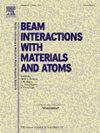α粒子诱导镝核反应激活截面的测量
IF 1.4
3区 物理与天体物理
Q3 INSTRUMENTS & INSTRUMENTATION
Nuclear Instruments & Methods in Physics Research Section B-beam Interactions With Materials and Atoms
Pub Date : 2025-03-13
DOI:10.1016/j.nimb.2025.165670
引用次数: 0
摘要
测定了50 MeV α粒子束在天然镝上诱导反应的激活截面。采用成熟的叠靶技术和活化法,采用高分辨率γ射线能谱法推导元素反应截面。由于实验数据非常不完整,实验旨在确定形成长寿命反应产物的活化截面。得到了160,161,163Er, 166g,167Ho, 157,159Dy和156g,160Tb的活化截面。结果与现有实验数据和TALYS模型计算的预测结果进行了比较。部分反应截面数据首次测得。本文章由计算机程序翻译,如有差异,请以英文原文为准。
Measurement of activation cross section of alpha-particle induced nuclear reactions on dysprosium
Activation cross sections were determined for reactions induced by a 50 MeV alpha-particle beam on natural dysprosium. The well-established stacked target technique and activation method were applied followed by high-resolution γ-ray spectrometry to deduce elemental reaction cross sections. As experimental data are very incomplete the experiment aimed to determine activation cross sections for formation of longer-lived reaction products. Activation cross sections were obtained for the formation of 160,161,163Er, 166g,167Ho, 157,159Dy and 156g,160Tb. Results were compared with the available experimental data and prediction of TALYS model calculation. Some of the reaction cross section data were measured for the first time.
求助全文
通过发布文献求助,成功后即可免费获取论文全文。
去求助
来源期刊
CiteScore
2.80
自引率
7.70%
发文量
231
审稿时长
1.9 months
期刊介绍:
Section B of Nuclear Instruments and Methods in Physics Research covers all aspects of the interaction of energetic beams with atoms, molecules and aggregate forms of matter. This includes ion beam analysis and ion beam modification of materials as well as basic data of importance for these studies. Topics of general interest include: atomic collisions in solids, particle channelling, all aspects of collision cascades, the modification of materials by energetic beams, ion implantation, irradiation - induced changes in materials, the physics and chemistry of beam interactions and the analysis of materials by all forms of energetic radiation. Modification by ion, laser and electron beams for the study of electronic materials, metals, ceramics, insulators, polymers and other important and new materials systems are included. Related studies, such as the application of ion beam analysis to biological, archaeological and geological samples as well as applications to solve problems in planetary science are also welcome. Energetic beams of interest include atomic and molecular ions, neutrons, positrons and muons, plasmas directed at surfaces, electron and photon beams, including laser treated surfaces and studies of solids by photon radiation from rotating anodes, synchrotrons, etc. In addition, the interaction between various forms of radiation and radiation-induced deposition processes are relevant.

 求助内容:
求助内容: 应助结果提醒方式:
应助结果提醒方式:


